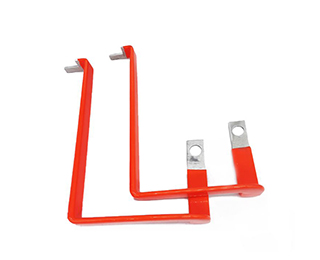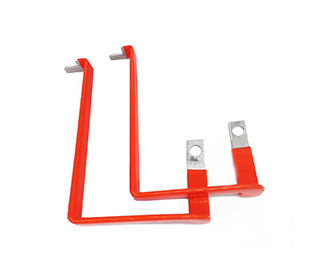


An insulated Flexible Busbar is a specialized electrical component designed for the safe and efficient conduction of electricity in complex and space-constrained systems. Made from high-conductivity materials such as copper or aluminum, these busbars are coated with insulating layers to prevent accidental contact, reduce the risk of short circuits, and ensure reliable operation. Flexible by design, insulated flexible copper bars are ideal for applications where rigidity is impractical or where efficient space utilization is critical.
1. Superior Electrical Conductivity
The use of high-quality copper in insulated flexible copper bars ensures excellent electrical performance with minimal energy loss. These busbars are capable of handling high current loads, making them suitable for industrial, renewable energy, and automotive applications.
2. Flexibility and Adaptability
One of the main advantages of an Insulated Flexible Busbar is its ability to bend and conform to tight or irregular spaces. This flexibility allows efficient routing in power systems, electric vehicles (EVs), renewable energy installations, and compact industrial equipment.
3. Durable and Heat-Resistant Insulation
The insulating layer, typically made of PVC, silicone rubber, or other high-performance polymers, provides protection against electrical shocks and short circuits. The insulation is heat-resistant, UV-resistant, and mechanically durable, ensuring long-term safety and reliability.
4. Space-Efficient Design
Thanks to their flexibility and compact structure, insulated flexible copper bars are perfect for environments with limited space, such as densely packed electrical enclosures, battery packs, and control panels. This design also reduces material usage and installation complexity.
5. Safety and Reliability
Insulation protects both personnel and equipment by preventing accidental contact with live components. Insulated Flexible Busbars provide secure connections in high-risk electrical environments, ensuring consistent performance over their service life.
6. Customization Options
These busbars can be tailored to specific requirements, including conductor size, insulation type, length, bending, and current rating. Manufacturers can create insulated flexible copper bars to match unique installation constraints and electrical loads.
1. Power Distribution Systems
Used to interconnect electrical components in industrial plants, commercial buildings, and residential setups, providing reliable current flow and reducing wiring complexity.
2. Renewable Energy Systems
In solar panels, wind turbines, and energy storage units, insulated flexible copper bars connect inverters, storage modules, and combiner boxes while adapting to tight or irregular spaces.
3. Electric Vehicles (EVs)
Critical for connecting battery packs, power electronics, and motors, ensuring efficient energy transfer while reducing weight and space usage.
4. Industrial Equipment
Used in machinery, automation systems, and robotics for safe and adaptable power distribution. Their flexibility supports frequent reconfiguration or system upgrades.
5. Data Centers and UPS Systems
Provide high-density, reliable connections in server racks, uninterruptible power supplies, and cooling systems.
6. Substations and High-Voltage Installations
Enable safe, efficient, and flexible distribution of electricity in substations and switchgear.
Material Selection: Copper or aluminum strips are chosen for high conductivity and mechanical durability.
Conductor Shaping: Conductive strips are processed into flat, flexible shapes to allow easy routing.
Insulation Application: Coated with PVC, silicone rubber, or other insulating polymers for safety.
Assembly: Insulated strips are stacked, wound, or configured to meet mechanical and electrical specifications.
Testing & Quality Control: Conductivity, voltage withstand, flexibility, and environmental resistance are verified.
Cutting & Packaging: Final products are cut to length, inspected, and packaged for shipment.
High electrical conductivity with minimal energy loss
Flexible design for tight or irregular spaces
Durable insulation with heat and UV resistance
Compact and space-efficient layout for complex systems
Fully customizable for current rating, shape, and insulation type
Compliant with IEC, UL, and other international safety standards
Our insulated flexible busbar and insulated flexible copper bars provide a reliable, safe, and adaptable solution for modern electrical distribution needs, ranging from industrial automation and data centers to renewable energy and EV systems.
Q1: What is an insulated flexible busbar used for?
A: An insulated flexible busbar is used for safe and efficient power distribution in electrical systems, renewable energy installations, electric vehicles (EVs), industrial automation, data centers, UPS systems, and substations. It ensures reliable current flow while adapting to tight or complex spaces.
Q2: What materials are used in insulated flexible copper bars?
A: Insulated flexible copper bars are typically made from high-conductivity copper strips. Aluminum can also be used in some applications. The copper provides excellent electrical conductivity and mechanical durability, making it suitable for high-current applications.
Q3: How is the insulation applied to flexible busbars?
A: The conductive strips are coated with insulating materials such as PVC, silicone rubber, or cross-linked polyethylene. This layer protects against electrical shock, short circuits, and environmental hazards while maintaining flexibility.
Q4: Can insulated flexible busbars be customized?
A: Yes, they can be customized for length, width, thickness, bending, insulation type, current rating, and shape to meet specific installation requirements. Insulated flexible copper bars can also be configured in stacked or multi-layer designs for higher current capacity.
Q5: What are the advantages of insulated flexible copper bars over rigid busbars?
A: Flexible busbars offer:
Adaptability to complex or cramped spaces
Reduced installation time and wiring complexity
Enhanced vibration resistance, ideal for EV and industrial applications
Safer connections with insulated layers preventing accidental contact
Q6: What temperature and environmental conditions can these busbars handle?
A: Insulated flexible busbars are designed to operate reliably in a wide temperature range (typically -40°C to +125°C) and are resistant to UV, moisture, and mechanical stress. Specific insulation materials may extend performance for harsher environments.